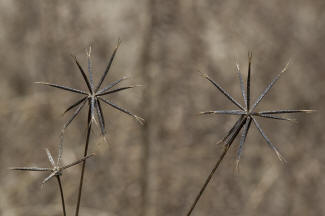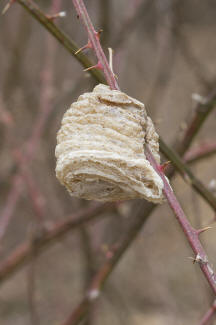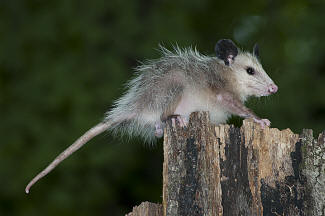PROFILES IN NATURE
Spanish Needle
Photo Credit – www.kentuckyupclose.com
Anyone that spends time out of doors should be familiar with this
plant. Even if one never ventures out of their yard but have pets
running loose then I am sure you have picked these seeds out of their
fur. What may not look familiar to some though is what these clusters of
seeds look like while still on the plant. Normally found sticking to
ones socks or soft clothing by the dozens, seeds of the Spanish Needle
or Bidens alba, are hated by
all outdoorsmen. Other common names include beggar-lice, shepards
needle, and a few that can’t be repeated in a family publication.
The first word in the scientific name Bidens, means two toothed
and refers to the two barbed prongs on the tip of the seed that is used
to attach itself to passing animals and humans. Alba refers to the white
petals on its flowers.
During the growing season Spanish needles have flowers that
measure from one half inch to over an inch across consisting of a
spherical yellow center and white petals. The noxious seeds do not
develop until late fall. Although they can be quite a nuisance one has
to admit that using humans and animals to scatter seed is a very
successful dispersal method. We have several other plants in our area
that share this same trait.
Although considered a noxious weed by most people the spanish
needle does have its good points. Young leaves can be used in salads,
older leaves can be cooked and eaten either fresh or dried, and there
are several medicinal uses including a treatment for cancer!
As usual though, when
describing edible or medicinal properties I must add the following
disclaimer, neither the paper nor myself are responsible for the
mis-identification and/or possible untoward effects from eating or
otherwise utilizing wild plants.
by Jack
Glisson
Published in The Ballard County Weekly 02/04/2015
PROFILES IN NATURE
Chinese Mantis
Photo Credit – www.kentuckyupclose.com
Once leaves drop in the fall one may start to notice egg cases of
the Chinese Mantis, Tenodera
sinensis. Commonly located in the edges of fields and yards on small
shrubs, weeds, blackberry bushes and such these foam egg cases tend to
go un-noticed until winter.
The common name “Praying Mantis” actually includes several
species. The Chinese mantid is the one that is most commonly seen in
this area and is also the largest. Introduced in 1896 for pest control
(depending on what source one reads, some say accidental) these insects
have found a niche that they do well in. Growing to a length of up to
five inches the adults have few other insect predators. The young
however lead a dangerous life. Eaten by other insects, birds, and even
each other, few survive.
Back to the egg cases. Called ootheca, this is mother natures
invention of Styrofoam long before man happened upon it. In fall the
adult female exudes a foamy froth around her egg catch and this hardens
into the case as seen above. Up to 300 young or nymphs will hatch the
following spring. I have noticed a preference for black berry briars for
the egg case placement, not sure why.
The common name praying mantis comes from the posture these
insects take while looking for prey. Perched in some inconspicuous place
the fore-legs are held in a position near the head that resembles
clasped hands in a praying posture. In reality, these forelegs are armed
with sharp spikes and any hapless prey animals that come within reach
are quickly grasped.
Mantises are voracious predators. If something moves within their
grasping range and is large enough to be food worthy but small enough to
be overpowered, they pounce. Lightning fast, once the prey is grasped in
the fore-legs escape is unlikely and it is then devoured. Unlike spiders
and assassin bugs the food is not liquefied and sucked out but rather
chewed off bite for bite and eaten. Feeding on mostly insects, the
Chinese mantid will eat anything that moves. This includes small
lizards, frogs, birds, and snakes!
Thousands of egg cases are sold annually for insect control in
gardens. This is a double edged sword however as the mantis eats all
insects, good or beneficial.
Jack
Glisson
Published in The Ballard County Weekly 02/18/2015
PROFILES IN NATURE
Virginia Opossum
Photo Credit – www.kentuckyupclose.com
Well, spring is trying to make its presence felt as is evident
with all of the small animals ran over on the road. It is mating season
for a lot of our small game and the Virginia Opossum is no exception.
Sexual persuasion however is not the only thing that increases
highway kills of the Didelphis
virginiana. Not being a very picky eater, all of the other road kill
semi preserved by cool weather makes the highway look like a buffet
dinner to opossums!
The only marsupial native to North America, the Virginia opossum
is actually quite an interesting little animal. One common trait of
marsupials is that they carry their young in a pouch like a kangaroo.
When young opossums are born after a gestation period of only 13 days
they are about the size of a pea. They must make their way from the
birth canal to the pouch or they will soon perish.
Once in the pouch they attach themselves to a teat where they
will remain for a few weeks. If there are more young than teats they
will not survive as they are born so immature that attachment must be
made to the mother. Once the young are old enough to detach from the
teat they will begin to crawl in and out of the pouch and may be seen
riding around on their mothers back and sides, clinging onto her fur
with their mouth and paws. The number of young usually ranges from six
to nine. Average life span for opossums in the wild is only one to
three years.
Like mentioned before, opossums are not picky eaters. Their diet
may include
rabbit, squirrel, mice, birds, eggs, worms, snakes, frogs, skunk, other
opossum, grapes, apples, berries, grains and insects. Freshness is not a
requirement!
When disturbed an opossum will usually attempt to run, if
cornered they will snarl, show their teeth, drool, and are quiet capable
of inflicting a bite. If the disturbance continue they may “play
possum”, feigning death and excreting a foul substance in hopes this
will deter the aggressor.
In the past opossum was considered good table fare. I remember
trapping for rabbits as a child using “rabbit gums” and occasionally I
would catch an opossum. My grandfather always wanted me to save these
for him. He wanted a young, maybe half grown individual and he would put
it up and “feed it out” using milk and cornbread for a couple of weeks.
He would then bake it in the oven with sweet potatoes and it really
wasn’t bad! A very similar taste to pork.
Jack
Glisson
Published in The Ballard County Weekly 02/25/2015


